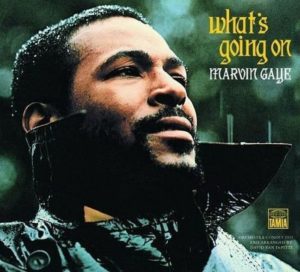Stories of Standards—Inner City Blues
 Tune in weekday mornings for Stories of Standards to hear our favorite versions of “Inner City Blues.” Rodney Franks presents Stories of Standards Monday through Friday at 7:50 and 8:50 a.m. starting Monday, March 30!
Tune in weekday mornings for Stories of Standards to hear our favorite versions of “Inner City Blues.” Rodney Franks presents Stories of Standards Monday through Friday at 7:50 and 8:50 a.m. starting Monday, March 30!
Stories of Standards is sponsored by ListenUp – If you love music, you’ll love ListenUp.
“Inner City Blues”, by Marvin Gaye and James Nyx, Jr., was initially released as the third single and final song of Gaye’s 1971 album “What’s Going On.” The song began as a tune without lyrics by Gaye. Nix said that they had begun putting together some lines about how tough things were around town, when Nix saw a headline about the “inner city” of Detroit. “And I said, ‘Damn, that’s it. ‘Inner City Blues.'” Gaye played piano on the original recording, which featured a one-minute reprise of the album’s first song “What’s Going On”, with a somber ending. The final minute was edited out of the single version, which is how it appears on subsequent editions of the album.
Marvin Gaye (Apr 2, 1939 – Apr 1, 1984) was born Marvin Pentz Gay Jr in Washington, D. C., where his first home was a public housing project, the Fairfax Apartments. He began singing in church when four years old, where his father often accompanied him on piano. Gaye described his home life as as similar to “…living with a king, a very peculiar, changeable, cruel, and all powerful king.” Frequently kicked out of his home, Gaye quit school and joined the United States Air Force, where he was given menial tasks to perform. Faking mental illness, he was given a “general discharge”. Snging with “The Marquees” and working with Bo Diddley, Gaye moved with the group to Chicago, where they worked as session singers for acts such as Chuck Berry. In 1960 after the group disbanded, Gaye moved to Detroit, where he signed with Tri-Phi as a session musician playing drums and met Berry Gordy while performing at Gordy’s house. Soon afterwards Gaye signed with Motown subsidiary Tamla. After several moderate hits as a writer and performer, his first major hit was “How Sweet It Is (To be Loved by You)”, written for him by Holland-Dozier-Holland., which reached #6 in the US and the top 50 in the UK. He began singing with Tammi Terrell, whose career was cut short by cancer, although she did manage to release “Ain’t Nothing Like the Real Thing” and “You’re All I Need to Get By”. In late 1968 Gaye’s recording of “I Heard It Through the Grapevine” became his first to hit #1 on the Billboard Hot 100. After Tammi Terrell died, Gaye sought a position on the Detroit Lions football, but was not allowed to try out as it was feared injuries would cut short his musical career. Inspired by an idea from Renaldo “Obie” Benson of the Four Tops who had witnessed police brutality at an anti-war rally in Berkeley, Gaye wrote “What’s Going On”, initially rejected by his recording label as “too political”. Gaye went on strike until the song was released in 1971; it reached #1 on the R&B charts within a month and sold two million copies. His album “Here, My Dear” was inspired by effects of his first marriage, to Anna Gordy, and intended to generate profits sufficient to pay alimony. Unfortunately it did not do well on the charts. He spent much of 1980 in London working on an album to be titled “In Our Lifetime?”. A master copy was stolen from one of his traveling musicians and taken to Motown’s Hollywood headquarters where it was remixed, the album art changed and the title changed to “In Our Lifetime”. After the “Sexual Healing Tour” in 1984, Gaye moved in with his parents; after Gaye intervened in a fight between his parents; his father shot Gaye twice.
Become a Member
Join the growing family of people who believe that music is essential to our community. Your donation supports the work we do, the programs you count on, and the events you enjoy.
Download the App
Download KUVO's FREE app today! The KUVO Public Radio App allows you to take KUVO's music and news with you anywhere, anytime!